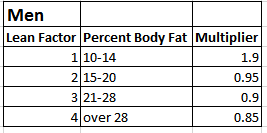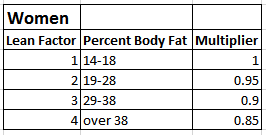
The amount of energy you burn in a given day,
and why it is important

Put simply, Basal Metabolic Rate is the amount of energy used in a given day by humans at rest. This is expressed in calories. This is the amount of calories an individual needs in order for their body to maintain normal bodily functions at rest.
However, if one eats less or more than their metabolic rate, their body will adjust to maintain homeostasis.
How do peoples rates differ from one another,
and how does one calculate their metabolic rate?
Basal Metabolic Rate depends on several factors, mainly:
- Body weight
- Lean factor
- Sex (Male / Female)
So how does one calculate Basal Metabolic Rate (BMR) ?
Men: 1.0 x BW (Bodyweight) (in kilograms [kg]) x 24
Women: .9 x BW [kg] x 24
Determine Lean Factor


So, how does this calculation work, and what good is it to know your BMR?
The more mass your body makes up, the more calories that are expended.
The more muscle you carry, the more calories your body burns
Women typically require less calories than men.
So why should you know and understand BMR?
Once you know your BMR, you can calculate your daily caloric expendeture and figure out how many calories your body burns in a given day. With this number, you are capable of adjusting and modifying your diet to reach your fitness goals. If your goal is to lose weight and you calculate your Daily Caloric Expenditure to be 2800 calories, you will need to eat less than 2800 calories to lose weight.
Your daily caloric expenditure is a multiplying factor based on your level of activity. For example, you take your BMR and multiply it by the following to determine your Caloric Expenditure.
1.30 – Your activity level consists of light activities, sitting, studying, talking, walking
1.55 – Your activity level is light with more moving, lab work, teaching, etc
1.80 – Your activity level consists of heavy manual labor or sports for a few hours per day
These can be used as a guideline for determining your own multiplying factor.
However, the formula above is not that simple for reaching your fitness goals.
An example of metabolic rate
Take a long distance runner. They do low intensity cardiovascular training for long durations of time. According to their activity level, they should be burning thousands of calories a day, but many runners don’t consume thousands and thousands of calories, and yet they are still able to function normally.
What happens in this example?
Low intensity, long distance aerobic exercise will actually LOWER your Basal Metabolic Rate. So a marathon runner’s body is meeting homeostasis because their bodily functions slow down so they are burning less calories. This allows them to continue to train and even run for many hours in a given day, but they do not need to consume an extra 5000 calories in order to do so.
So what does this bit of information mean for you?
For one, your metabolic rate is subject to change very often, depending on your activity level.
Second, with this variability, you will need to continue to recalculate your Basal Metabolic Rate as you progress in a training program. The more muscle you build, the more or less you weigh, and the more or less exercise you perform, you will have a different daily expenditure of calories.
Third, just doing cardio isn’t going to allow you to burn those layers of fat off.
Fourth, low intensity cardio is not the way to go for cutting body fat.
So how does one understand their metabolic rate, what is a good metabolic rate to have, and how do you get there?
When you see a person decide to “lose weight” and go on a diet, they cut their calories drastically, thinking this is going to provide them with the results they are looking for. What really happens? Their body slows down to meet homeostasis and they don’t lose any weight. The first initial pounds they lose are usually water weight, they gain the weight back, and sometimes gain even more weight than they originally held because their body goes into survival mode and they tend to store more body fat.
A person should seek to do the complete opposite of this. An individual seeking to reach thier fitness goals should aim to reach the highest metabolic rate possible while reaching homeostasis. That way, they are not starving their body from essential calories, vitamins, and minerals needed to survive, and they are able to cut off layers of body fat and maintain a lean, healthy physique without cutting more and more calories.
There are many ways to do this, and many different methods that will be discussed in future blog posts. However, I will provide one important piece of information for people looking to reach their goal physique / level of fitness and reach a healthy metabolic rate: Lifting weights, building muscle, High intensity cardio, and eating MORE are four keys to keeping a high metabolic rate while maintaining a lean level of fitness.
Lifting weights will keep your activity level higher, building muscle will make your body require more calories to consume, high intensity cardio will have an opposite effect from the marathon runner situation and will increase your metabolic rate, and eating more will allow your body to reach a higher caloric level of homeostasis.
With these several principles, you can understand why ‘cutting calories’ just won’t cut it for the level of fitness you seek to acquire. You need to understand simple concepts such as BMR in order to truly reach your level of fitness.[/text_block]

Just enter your email in the form on the right and we’ll notify you when we add new articles to this section.

![]() We value your privacy and would never spam you
We value your privacy and would never spam you